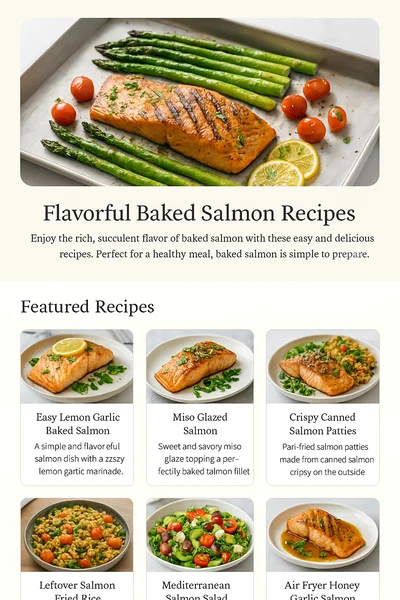Maple Glazed Salmon

A simple maple soy glaze caramelises on baked salmon for a sweet-savory dinner. This elegant yet effortless recipe transforms basic ingredients into a stunning main course with a beautiful lacquered finish. The pure maple syrup creates a gorgeous caramelization while balancing the salty soy sauce and tangy Dijon mustard, resulting in a complex flavour profile that tastes like it took hours to prepare.
Ingredients
- 4 salmon fillets
- 1/4 cup pure maple syrup
- 2 tablespoons soy sauce
- 1 tablespoon Dijon mustard
- 2 cloves garlic, minced
- Salt and pepper, to taste
Instructions
- In a small bowl whisk together the maple syrup, soy sauce, Dijon mustard and minced garlic.
- Place the salmon in a shallow dish and pour over half of the glaze. Marinate for 15 minutes.
- Preheat the oven to 400°F (200°C). Arrange the salmon on a baking sheet lined with parchment; season with salt and pepper.
- Bake for 15–20 minutes, basting with the remaining glaze halfway through, until the salmon is cooked and caramelised.
- Serve with extra glaze drizzled on top.
Equipment Needed
- Baking sheet or roasting pan
- Parchment paper or aluminum foil
- Small mixing bowl for glaze
- Whisk or fork
- Basting brush (silicone or natural bristle)
- Shallow dish for marinating
Tips & Variations
- Pure maple syrup only: Use real, pure maple syrup for the best flavour. Pancake syrup or imitation maple will not caramelize properly or deliver authentic flavour.
- Marinating time: Fifteen minutes is ideal, but you can marinate for up to 2 hours in the refrigerator for deeper flavour penetration.
- Basting technique: Baste salmon halfway through cooking to build layers of glaze and achieve that signature glossy finish.
- Watch for burning: Maple syrup can burn quickly. If the glaze darkens too much, tent the salmon with foil for the remaining cooking time.
- Add spice: Incorporate cayenne pepper, red pepper flakes, or fresh grated ginger for a spicy-sweet variation.
- Citrus twist: Add orange zest or a splash of orange juice to the glaze for a bright, fruity dimension.
Nutritional Information
Per serving (1 fillet):
- Calories: 310
- Protein: 34g
- Fat: 10g (Saturated: 2g)
- Carbohydrates: 18g
- Fiber: 0g
- Omega-3 Fatty Acids: 2.2g
- Sodium: 650mg
- Sugar: 15g
High in protein and omega-3 fatty acids. The maple glaze adds natural sweetness with minerals like manganese and zinc not found in refined sugars.
Storage & Reheating
Refrigerator: Store in an airtight container for up to 3 days. The glaze acts as a protective coating, keeping the salmon moist.
Freezer: Freeze cooked glazed salmon for up to 2 months in a freezer-safe container. The glaze freezes exceptionally well.
Reheating: Reheat in a 300°F (150°C) oven for 8-10 minutes until warmed through. You can also reheat in the microwave for 1-2 minutes, though the oven method better preserves the glaze texture.
Serve cold: Maple glazed salmon is delicious served cold or at room temperature in salads, making it excellent for meal prep.
Serving Suggestions
Pair your maple glazed salmon with:
- Vegetables: Roasted Brussels sprouts, green beans, asparagus, or glazed carrots
- Starches: Wild rice, quinoa, mashed sweet potatoes, or roasted fingerling potatoes
- Salads: Spinach salad with candied pecans, kale Caesar, or arugula with balsamic dressing
- Grains: Farro, couscous, or brown rice pilaf
- Seasonal sides: Butternut squash in fall, fresh corn in summer, or roasted root vegetables in winter
Recipe Notes
Oven temperature: Baking at 400°F (200°C) allows the glaze to caramelize without burning while cooking the salmon through perfectly.
Parchment paper trick: Line your baking sheet with parchment to prevent sticking and make cleanup effortless. The glaze can be sticky.
Thickness matters: Adjust cooking time based on fillet thickness. Thin fillets (3/4 inch) need 12-15 minutes; thick fillets (1.5 inches) need 18-22 minutes.
Dijon substitute: Whole grain mustard adds texture, or use yellow mustard for a milder flavour. Honey mustard works for extra sweetness.
Make extra glaze: Double the glaze recipe and reserve half for drizzling over the cooked salmon and side dishes for maximum flavour.
Skin removal: The skin slides off easily after baking. Use a spatula to lift the fillet, leaving the skin behind on the parchment paper.